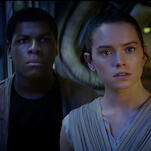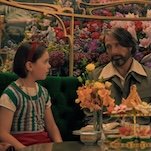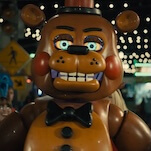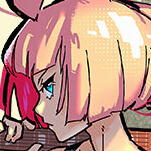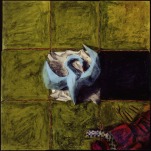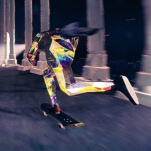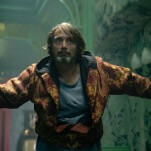January 15, 2010
Although there’s never going to be a better time to take advantage of the hype, it’s hard to think of a compelling reason for Christian De Metter’s Shutter Island (HarperCollins) to exist. The adaptation is faithful enough—Dennis Lehane has been enthusiastic about it—and De Metter’s washed-out, muted watercolor style is an effective way of expressing the tone of the surreal horror-mystery. But aside from the art, which can be enjoyed just as well in better De Metter works like Le Sang Des Valentines and Vers Le Demon, the comic adds nothing to the novel, and it’s doubtful that anyone who enjoys the movie will be tempted to seek it out. Useful only for spoiling the movie for those who haven’t already read the book—a feat that can be performed for free on the Internet—it’s accomplished without actually accomplishing anything… B-
One of the funniest jokes in Gahan Wilson: Fifty Years Of Playboy Cartoons (Fantagraphics)—a massive, three-volume, nearly thousand-page collection—comes at the end. The “Index Of Abhorations” lists occurrences of everything from “bear” (one) to “Y2K” (two). Most subjects only make a handful of appearances until “Alien(s),” “Monsters(s),” “Chaos and destruction,” and “Gigantic,” all of which dwarf the topics around them. (“Demented Santa” makes a lot of appearances, too.) Since 1957, Wilson’s work has provided a grim counterpoint to the skin and pleasure-seeking of Playboy. Twisting pop-culture icons to dark-witted ends, Wilson places his characters in a world of terror and understatement. In one color cartoon from 1968, for example, a concerned-looking woman walks arm-in-arm with a half-man/half-fish beastie straight out of Lovecraft. The caption: “Harry, I really think you ought to go to the doctor.” Wilson’s gags range from the wistful to the barbed without warning. He rarely has an explicit political point to make, and apart from the occasional topical reference and the annual New Year’s cartoon, most of the cartoons take place in an indefinite era. But the incidental commentary here about human selfishness and shortsightedness squeezed between the B-movie monsters and little green men feels timeless, as does the remarkably high level of quality Wilson has maintained over the years. The later cartoons have a slightly broader, more grotesque look, but the same droll, cobwebbed wit. “I’m so glad you enjoyed our little dinner,” a token bride tells her elderly dining companion in a 2007 effort, “and that you didn’t taste the poison.” Wilson landed his longtime gig because Hugh Hefner, once an aspiring cartoonist himself, wanted Playboy to have its own Charles Addams. Instead, he got a talent with a funny, unsettling voice all his own… A
The first two books in the “Vertigo Crime” graphic-novel series came off more like typical Vertigo fare (albeit in black-and-white) than like any kind of game-changer for the medium. The third book, The Chill, is more distinctive, thanks largely to writer Jason Starr, a veteran crime novelist making his first foray into the medium. Unlike a lot of comics novices, Starr works well with his artist (Mick Bertilorenzi), putting together a 180-page comic that holds together as a comic, while also aspiring to the heft of a novel or a movie. The Chill follows a police investigation into the crimes of a pair of aged Irish serial killers—father and daughter—who enchant young men, then slaughter them. One of the family’s first victims, a former Boston beat cop whom they attacked in the old country, long ago, tries to clue the NYPD in to what’s going on, but gets dismissed as a crackpot, and has to rely on knowledgeable priests and vloggers to aid his own pursuit of the bad guys. Starr paces the story well, revealing little details about the characters in and around some bloody murder scenes. But the sensational elements are what make The Chill such a kick: the frequent nudity, the ritual dismemberment, the nods to Druidic folklore, and so on. The Chill would make an entertaining throwback drive-in movie; as it is, it’s a gripping graphic novel… B+
The Unwritten: Tommy Taylor And The Bogus Identity (Vertigo) collects the first five issues of Mike Carey and Peter Gross’ excellent new series, all about a well-known fantasy author’s son who may in fact be the author’s most famous character come to life. Carey and Gross have some fun in the early going with the parallels between Tommy Taylor and Harry Potter, and with comparing and contrasting a fictional world of spells and puzzles with our more mundane world, where people merely obsess over books full of spells and puzzles. (The cleverest recurring conceit in The Unwritten involves excerpts from all the blogs, fan sites, and message boards where people speculate about who Tommy Taylor really is and what he’s up to.) But while the adventures of a confused, internationally famous, possibly fictional young adult are plenty entertaining all on their own, The Unwritten has also deepened from issue to issue, adding new components to the mystery of Tommy Taylor’s existence while suggesting a vast conspiracy to control the opinions of the populace through what they read for pleasure. This first collection is too short (though it’s also bargain-priced, which is nice), but at least it ends with the series’ best story yet, “How The Whale Became,” which imagines a career-long back-and-forth between Rudyard Kipling and the secret cabal that runs the world. With that story, The Unwritten makes a leap from being just a promising new Vertigo title to being on-track to become the best ongoing Vertigo book since Sandman. And given that Vertigo has delivered the likes of 100 Bullets, Y: The Last Man, and Fables since Sandman ended, that’s saying something… A-
Less instantly grabbing, but possibly deeper, is Vertigo’s new Daytripper limited series, which has Brazilian twins Gabriel Bá (Umbrella Academy) and Fábio Moon (Casanova) collaborating again, this time on a largely down-to-earth slice of life about a wannabe writer living in São Paulo, Brazil in the shadow of his more famous father. At least that’s what it appears to be from the first issue, which ends in an unexpected place that seems to obviate the need for a second one. Nonetheless, issue No. 2 takes up the protagonist’s story at an earlier, less fixed time in his life, as he wanders Brazil with a good friend and learns a bit more about life than he seemed to know in the later age of issue No. 1. Issue No. 2 ends much like the first one did, which undoes the previous story, deepens its mystery, and suggests a pattern for the next eight issues to come, but so many questions have been raised at this point that it might make sense to wait for a trade collection and read the whole series at once. Bá and Moon establish an appealingly patient pacing, taking their time on establishing details of characters and setting, but neither of these standalone stories necessarily go anywhere exceptional on their own. The second is a sweeter, stronger installment than the first, and the texture of the art and the story both suggest this will be a memorable project when it’s done. For now, it seems too fractional to have found its feet… B
As high-concept videogames go, Dante’s Inferno, due out in February, has to be one of the more ridiculous ideas ever to come down the pike. Hiring the guy who wrote Monster’s Ball to create a hack-and-slash actioner based on Dante Alighieri’s epic poem of spiritual allegory and religious terror is goofy enough, but add to the fact that Dante is portrayed as a sort of crusading super-wizard/paladin who rescues his girlfriend Beatrice from Hell, and you’ve got the most misbegotten classical adaptation since Demi Moore’s The Scarlet Letter. Now take away even the moderate literary talents of Will Rokos, replace him with the generally incoherent Christos Gage, and provide some striking but impenetrable art by Diego Latorre, and you’ve got Dante’s Inferno (Wildstorm), which is inessential even by the low standards of comic-book to videogame adaptations… C-
And speaking of pointless adaptations, perhaps the most pointless is Weekly World News: The Irredemption Of Ed Anger (IDW). Chris Ryall, the company’s editor-in-chief and author of the four-issue miniseries, seems to predict the common objection: Every interview he’s done about WWN begins with him spieling some variant of “You’re probably asking yourself, why bother?” Readers will probably still keep asking themselves that; although it’s clearly a labor of love for Ryall, it’s unlikely to resonate with anyone who doesn’t fondly remember the over-the-top, self-parodying newspaper tabloid. And even those who do will notice that the story isn’t much, humor-wise, beyond ‘I remember that!’ referential gags about Bat Boy, space aliens, and freeze-dried babies. Barely passable art by Alan Robinson doesn’t help much either. The best part of the comic is the back matter, which excerpts actual Weekly World News articles, including some choice selections from their (fictional) ultra-right-wing columnist, Ed Anger… C
To continue the theme… Stephen King fans certainly aren’t lacking for comic-book adaptations these days, with Dark Tower: The Battle Of Jericho Hill underway and The Stand continuing to roll out, both at Marvel. Del Rey Comics has picked up the mantle with The Talisman: The Road Of Trials, the first arc in a planned multi-year adaptation of The Talisman, the 1984 fantasy novel by King and Peter Straub. Scripted by Robin Furth, King’s research assistant and co-writer on the Dark Tower comics series, Road Of Trials just hit issue No. 3, and it’s moving along at a measured pace, necessarily dropping a lot of the novel’s texture, but keeping in even minor dialogue and action. Still, the art is somewhat annoying—the characters’ set faces and awkward stiffness often suggests an overreliance on photographic reference at the expense of looseness and expression, and everything from the panels to the poses seems too rigid. That, and the texture of the novel was much of its appeal. Much like the Stand adaptation, this take on The Talisman feels like an old Classics Illustrated comic, with all the busy incident and none of the richness of the original… C+
One of the best-looking series of last year had a somewhat predictable ending, but the route it took to get there was terrific. No wonder Image opted for the hardcover, oversized, glossy release treatment for the collected edition of Steven T. Seagle and Marco Cinello’s Soul Kiss, turning it into something fairly close to a small pop-art poster book. The story follows a woman who makes a bargain with the devil to save herself from a would-be rapist, and winds up with the unwanted power to send people to hell with a kiss, and the unwanted responsibility to choose 10 souls to make the trip. Cinello uses Seagle’s vividly emotional framework as an excuse for equally vivid pages, some keyed to a single bright color or tone, some designed so Seagle’s brassy, prickly heroine practically pops off the page. The art is executed in various degrees of stylization, with big, dramatic splash pages alternating with Eisner-esque panel experiments and conventional boxes; sometimes it’s all loose, jazzy, and free-form, while at other times it’s finely detailed and formalist. Either way, it’s generally beautiful… A-





